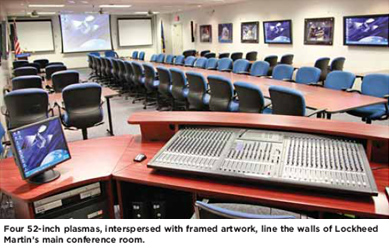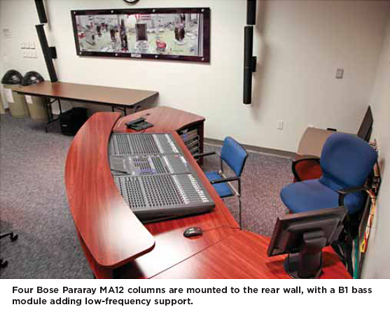Upgrading an AV Image

By Matt Wunsch
Imagine a company as prestigious as Lockheed Martin trying to hold a conference with a portable PA system and a few Radio Shack microphones. Not very impressive.
Things weren't that bleak for their Philadelphia-area Commercial Space Systems headquarters before a recent upgrade, but they weren't keeping up with the technological innovation the company is known for in the aeronautical/military arenas. This division of Lockheed Martin is at the forefront of a space-based telecommunications revolution that is connecting the world through voice, data, fax, television, radio, and multimedia. William Kearns, senior media production analyst who has spent ten years with Lockheed Martin in Newtown, PA, recognized those inconsistencies and decided to facilitate an upgrade to make conferencing smoother and easier for both speakers and listeners.
It all started back in the fall of 2007 during an AV project that took roughly three months to complete with the assistance of KSB Telesound, a Trenton, NJ-based provider of business communications systems. "In the corporate world, they're just starting to recognize that presentation systems are necessary in more than just one or two places in the corporate headquarters, so this installation was kind of a big deal," Kearns explains.
"We had sort of a traditional wireless microphone setup in the main conference room with some loudspeakers in the ceiling and a little stack of anti-feedback filters in there. Somebody at some point had jammed a couple of shotgun microphones in the ceiling on little 4-inch extensions. That's something that's pretty common, but it's an inferior approach, and the executive folks were not really happy with it."
Kearns explains that a pilot upgrade in an executive office much smaller than the long rectangular conference area was the first step. He describes the main conference room with an 18-foot conference table and one of its walls made of glass as a feedback nightmare. "Ceiling loudspeakers can be a problem in any room. I can't fathom why any self-respecting engineer would ever go there when handling live sound. Rule number one- don't point the speakers at the microphone!" Some serious work on both the audio and visual end was needed, and so began the experiment in the smaller room.
"Essentially we took a couple of Sennheiser ME35s back electret condenser mic heads and put those on the end of a couple of 18-inch goosenecks towards the front of the room. Then we added two more ME35s on 4-inch goosenecks to either side of the projection screen," Kearns says, adding that his previous days as a musician paid off during the trial run. "It dawned on me that the loudspeakers in the ceiling, no matter what you did with filters, were just sort of...not going to cut it."
A daily selection of features, industry news, and analysis for tech managers. Sign up below.
With a decent loudspeaker budget to work with, he went to the Bose Professional catalog. "They had recently come out with the L1 portable line array systems for musicians, featuring very wide 160-degree dispersion and very narrow vertical dispersion," Kearns recalls. "So we took two of their Panaray MA12 wallmounted versions for commercial use, put them in the rear of the room pointed towards the front and tilted them down somewhat to take advantage of that narrow vertical dispersion. Then we put two really clean QSC PLX3602 amplifiers in the back, and the sound from the loudspeakers was excellent."
From there it was a matter of using what Kearns termed as "common sense" in the small room and converting that to the larger, liveliersounding conference room.
That's when KSB Telesound was called in for the larger installation that ended up featuring six of the Bose columns. They brought in four AV technicians in order to upgrade what KSB technical sales manager Rob Leiggi, a nearly 30-year veteran in the industry, described as a "very minimal AV system." "The old system allowed only three individuals to speak, which is very limiting - it was designed to allow only the main presenters to speak via the system. The new system was designed, equipped, and installed so that all conference meeting attendees could participate," he says. "Also there was only one viewing screen. Now there are seven."
The project cost nearly $80,000, but yielded impressive results. Four Sony 52-inch FWD- 50PX2 commercial plasma screens along with three NEC LT380 projectors provide the video muscle that was lacking, according to Leiggi. An Extron Crosspoint 450+ Series switcher was also implemented to select from a variety of video signal sources. "The Extron controls which computer or any other video sources are displayed anywhere in the room or in multiple destinations," he says. "That leaves for a lot of flexibility during a presentation."
On the microphone front, KSB installed a total of 16 Sennheiser ME35 capsules using Sennheiser MZC30 suspension cables. The MZC30 cables have an integrated preamp and are reinforced with Kevlar for added strength. "Quite the upgrade," says Leiggi. "Now all meeting participants can speak via the audio system while multiple video images and programs can be viewed simultaneously."

Kearns is even more enthused with the results, especially since they were able to integrate some familiar technology that appeals to his musical sensibilities - a Yamaha GA 32/12 analog mixing console that is always on. "It's based on something that (jazz musician) Herbie Mann had in his studio, but that's another story. The one we have is the last one we could find in the country - a salesman's demo!"
It goes to show, analog has its place in certain situations - crashing is not an issue. "When I put in sound systems now, I am aware of stability issues," says Kearns. "So I won't put in anything that is computer controlled unless I'm really convinced how stable it is. I've never had a Mackie or Yamaha analog mixer quit on me, ever."
Results of the installation have been impressive on a number of levels. "What we wound up with is something really unique in the corporate universe," Kearns adds. "We got away from the traditional approach and took advantage of some of the higher end systems out there. Using the technical innovators like Bose and Sennheiser has worked for us. They are really sharp and accurate in what they advertise."
Freelance writer Matt Wunsch is a studio musician who lives in Wakefield, Rhode Island. He can be reached atmattywunsch@yahoo.com.
The AVNetwork staff are storytellers focused on the professional audiovisual and technology industry. Their mission is to keep readers up-to-date on the latest AV/IT industry and product news, emerging trends, and inspiring installations.
